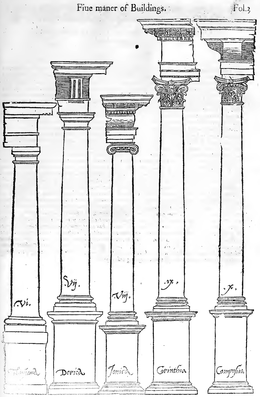
Classical architecture usually denotes architecture which is more or less consciously derived from the principles of Greek and Roman architecture of classical antiquity, or sometimes more specifically, from De architectura (c. 10 AD) by the Roman architect Vitruvius.[1][2] Different styles of classical architecture have arguably existed since the Carolingian Renaissance,[3] and prominently since the Italian Renaissance. Although classical styles of architecture can vary greatly, they can in general all be said to draw on a common "vocabulary" of decorative and constructive elements.[4][5][6] In much of the Western world, different classical architectural styles have dominated the history of architecture from the Renaissance until World War II. Classical architecture continues to inform many architects.
The term classical architecture also applies to any mode of architecture that has evolved to a highly refined state, such as classical Chinese architecture, or classical Mayan architecture. It can also refer to any architecture that employs classical aesthetic philosophy. The term might be used differently from "traditional" or "vernacular architecture" although it can share underlying axioms with it.
For contemporary buildings following authentic classical principles, the term New Classical architecture is sometimes used.
- ^ Fleming, John; Honour, Hugh; Pevsner, Nikolaus (1986). Dictionary of architecture (3 ed.). Penguin Books Ltd. p. 76. ISBN 0-14-051013-3.
- ^ Watkin, David (2005). A History of Western Architecture (4th ed.). Watson-Guptill Publications. pp. 6–8. ISBN 0-8230-2277-3.
- ^ Fleming, John; Honour, Hugh; Pevsner, Nikolaus (1986). Dictionary of architecture (3rd ed.). Penguin Books Ltd. p. 76. ISBN 0-14-051013-3.
- ^ Fleming, John; Honour, Hugh; Pevsner, Nikolaus (1986). Dictionary of architecture (3rd ed.). Penguin Books Ltd. p. 76. ISBN 0-14-051013-3.
- ^ Watkin, David (2005). A History of Western Architecture (4 ed.). Watson-Guptill Publications. pp. 6–8. ISBN 0-8230-2277-3.
- ^ Summerson, John (1980). The Classical Language of Architecture. Thames and Hudson Ltd. pp. 7–8. ISBN 0-500-20177-3.